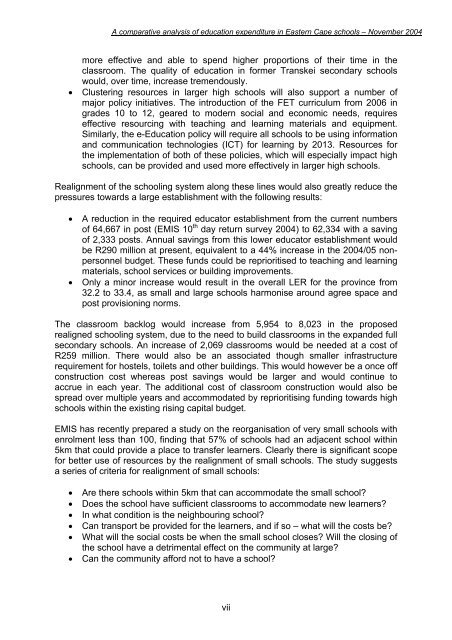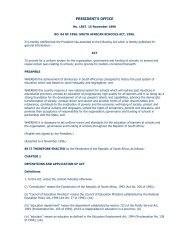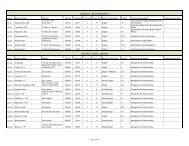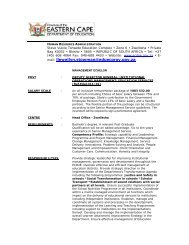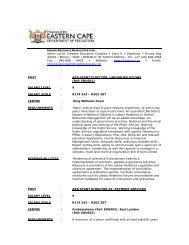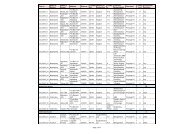School Community Integration Pilot Project - Department of Education
School Community Integration Pilot Project - Department of Education
School Community Integration Pilot Project - Department of Education
You also want an ePaper? Increase the reach of your titles
YUMPU automatically turns print PDFs into web optimized ePapers that Google loves.
A comparative analysis <strong>of</strong> education expenditure in Eastern Cape schools – November 2004<br />
more effective and able to spend higher proportions <strong>of</strong> their time in the<br />
classroom. The quality <strong>of</strong> education in former Transkei secondary schools<br />
would, over time, increase tremendously.<br />
• Clustering resources in larger high schools will also support a number <strong>of</strong><br />
major policy initiatives. The introduction <strong>of</strong> the FET curriculum from 2006 in<br />
grades 10 to 12, geared to modern social and economic needs, requires<br />
effective resourcing with teaching and learning materials and equipment.<br />
Similarly, the e-<strong>Education</strong> policy will require all schools to be using information<br />
and communication technologies (ICT) for learning by 2013. Resources for<br />
the implementation <strong>of</strong> both <strong>of</strong> these policies, which will especially impact high<br />
schools, can be provided and used more effectively in larger high schools.<br />
Realignment <strong>of</strong> the schooling system along these lines would also greatly reduce the<br />
pressures towards a large establishment with the following results:<br />
• A reduction in the required educator establishment from the current numbers<br />
<strong>of</strong> 64,667 in post (EMIS 10 th day return survey 2004) to 62,334 with a saving<br />
<strong>of</strong> 2,333 posts. Annual savings from this lower educator establishment would<br />
be R290 million at present, equivalent to a 44% increase in the 2004/05 nonpersonnel<br />
budget. These funds could be reprioritised to teaching and learning<br />
materials, school services or building improvements.<br />
• Only a minor increase would result in the overall LER for the province from<br />
32.2 to 33.4, as small and large schools harmonise around agree space and<br />
post provisioning norms.<br />
The classroom backlog would increase from 5,954 to 8,023 in the proposed<br />
realigned schooling system, due to the need to build classrooms in the expanded full<br />
secondary schools. An increase <strong>of</strong> 2,069 classrooms would be needed at a cost <strong>of</strong><br />
R259 million. There would also be an associated though smaller infrastructure<br />
requirement for hostels, toilets and other buildings. This would however be a once <strong>of</strong>f<br />
construction cost whereas post savings would be larger and would continue to<br />
accrue in each year. The additional cost <strong>of</strong> classroom construction would also be<br />
spread over multiple years and accommodated by reprioritising funding towards high<br />
schools within the existing rising capital budget.<br />
EMIS has recently prepared a study on the reorganisation <strong>of</strong> very small schools with<br />
enrolment less than 100, finding that 57% <strong>of</strong> schools had an adjacent school within<br />
5km that could provide a place to transfer learners. Clearly there is significant scope<br />
for better use <strong>of</strong> resources by the realignment <strong>of</strong> small schools. The study suggests<br />
a series <strong>of</strong> criteria for realignment <strong>of</strong> small schools:<br />
• Are there schools within 5km that can accommodate the small school?<br />
• Does the school have sufficient classrooms to accommodate new learners?<br />
• In what condition is the neighbouring school?<br />
• Can transport be provided for the learners, and if so – what will the costs be?<br />
• What will the social costs be when the small school closes? Will the closing <strong>of</strong><br />
the school have a detrimental effect on the community at large?<br />
• Can the community afford not to have a school?<br />
vii


